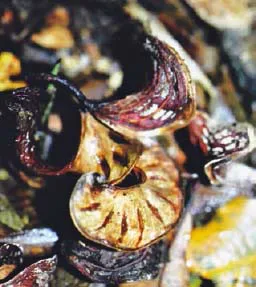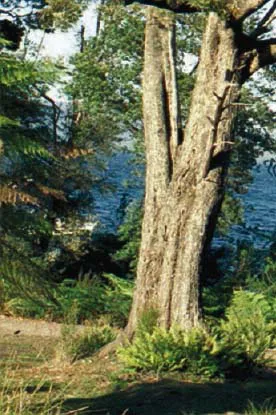![]()
Rainforest species used for their woods
This section provides the tools for identifying 140 rainforest species used for their woods, plus the properties and characteristics of their wood.
Members of the International Wood Collectors Society in south-east Queensland before spending time in this private remnant rainforest.
Acacia celsa brown salwood
Brown salwood on the rainforest edge.
Curled seed pods on the ground showing diagonal ribbing.
Synonym: Previously included in Acacia aulacocarpa.
Derivation: Acacia from the Greek aka (a point) referring to the spiny stipules that characterised the first (African) species. Dioscorides used the word in the 1st century AD for the Egyptian thorn tree (Acacia arabica) which was prickly. Celsa from celsus (high or lofty).
Family: Mimosaceae, which contains 40 to 60 genera with about 3000 species in Australia, America, Africa, Asia, Malaysia, the Pacific Islands and New Guinea. There are 17 genera with over 1100 species in Australia. Twelve genera and around 48 species are found in rainforests. Acacia is the largest genus, containing more than 1000 species. They generally form a lower layer of trees or shrubs and are found in rainforests as well as open forests. It is a modern family known to be around 25 million years old.
Other names: Black wattle, hickory wattle and brush ironbark wattle.
Distribution: Common in north-east Queensland extending from south of Cooktown to the Atherton Tableland and a small area north-west of Townsville. Acacia celsa is a member of the Acacia aulacocarpa ‘group’ as defined by B.R. Maslin, which includes A. aulacocarpa, A. disparrima as well as A. celsa. It is easily confused with these. However, Les Pedley of the Queensland Herbarium confirmed A. celsa as the only one of this group producing millable timber, and is found as a pioneer or canopy species in rainforest habitats. Acacia aulacocarpa is generally too small even though it does extend as far north as Cooktown and A. disparrima is found further south in the lower Fitzroy Basin and associated with dry, open woodland.
The tree: Grows to 30 metres tall with a single straight stem in the rainforest environment, however sparingly branched as in the photo on the left. Trunk to 0.3 metres diameter with a dark brown, hard but thin bark with very shallow grooves. The branchlets are flattened and acutely angled where they form a light green colour at the branch extremities. Their presence is often a sign of earlier disturbance, either from a cyclone or logging. Other species will eventually replace it. The leaves, which are actually phyllodes or stem extensions, are long, have a leathery texture, smooth, dark green to grey-green with a slight sheen. The longitudinal nerves run very close together and the secondary nerves are very well pronounced. The leaf is pulvinus, in that the cells at the base of the phyllode can rapidly move water into or out of the leaf and so change its turgidity and therefore its angle to the light. Four to eight pale lemon-yellow flower spikes form in the axil of the phyllodes. The seed pods are very conspicuous on the ground. While on the tree they split along the back and curl to expel the seeds.
Wood of Acacia celsa
The heartwood is light brown to brown with darker markings. The sapwood is pale yellow to pale brown. The texture is coarse but even and the grain straight. It is hard but easy to work and finishes well. It has an air dried density at 12% of 690 kg/m3. It has a shrinkage of 1.5% radially and 4% tangentially, and bends and glues well. It has been used for framing, weatherboards, joinery and furniture, although it reacts with metal, so care should be taken if it is nailed green. Also used for veneer and turning, fishing rods, archery bows, tool handles and light boat building.
See macrophotographs of Acacia celsa on page 187.
Acacia melanoxylon blackwood
A large 200-year-old blackwood in Dismal Swamp, north-west Tasmania.
Derivation: Acacia from the Greek aka (a point) referring to the spiny stipules that characterised the first (African) species. Dioscorides used the word in the 1st century AD for the Egyptian thorn tree (Acacia arabica) which was prickly. Melanoxylon from the Greek melanos (black) and xylon (wood), therefore blackwood.
Family: Mimosaceae, the wattle family. Generally forming a lower layer of trees or shrubs and found in rainforests as well as open forests. It is a modern family known to be around 25 million years old.
Other names: Black wattle, sally wattle, Paluma blackwood, hickory wattle and mudgerabah.
Distribution: Has a wide distribution, growing from the Atherton Tableland in north Queensland to Tasmania, and west to south-eastern South Australia. It grows from sea level to 1500 metres. Blackwood is found in cool temperate rainforests and tall open forests of eastern Australia and in the cooler south on undulating coastal lowlands. It is common in open forests only as a smaller tree and as a small shrub in mountain heath.
The tree: Often 10–20 metres tall and up to 0.5 metres in diameter, but varies from a small mountain shrub to one of the largest acacias in Australia, attaining heights of 50 metres and a diameter of up to a metre on lowland stands in north-west Tasmania, and in the Otways area in Victoria. In dense stands the larger plants have well-developed trunks; however, in open situations the medium and smaller blackwood trees are freely branched from near ground level. Bark is brownish to dark grey, hard and with longitudinal furrows with only slight transverse connections. Seedlings have the typical bipinnate leaf with 12–15 pairs of leaflets. Adult phyllodes (leaves) are relatively wide, almost straight with prominent longitudinal veins, developing a sickle shape when mature. Pale yellow ball-like flowers develop in heads of 3–5 balls, and develop into flat, rather thin seed pods which when ripe twist irregularly forming up to two complete tight coils. The wide adult phyllodes and the twisted and coiled fruit are good identification points for the blackwood.
As a large tree it associates with mountain ash (Eucalyptus regnans), messmate (E. obliqua) and manna gum (E. viminalis). At higher altitudes there may be myrtle beech (Nothofagus cunninghamii) and Antarctic beech (N. moorei), and with one of the larger fern trees (Dicksonia antarctica) in cool wet areas. In the drier and warmer areas it associates with many eucalypts, and among shrub vegetation with several other acacias. Blackwood has been planted in many other countries.
Typical trunk of a more exposed blackwood, showing early branching. Sarah Island, Macquarie Harbour, Tasmania.
Young phyllodes (leaves) are fairly straight and wide, compared to the sickle shape of the adult leaves.
Flowers.
Wood of Acacia melanoxylon
The heartwood varies in colour according to the region, although it is generally golden-brown with narrow bands of dark brown growth rings. Sometimes there are occasional black or reddish streaks. Heartwood colour is occasionally a very dark brown, and the ...








